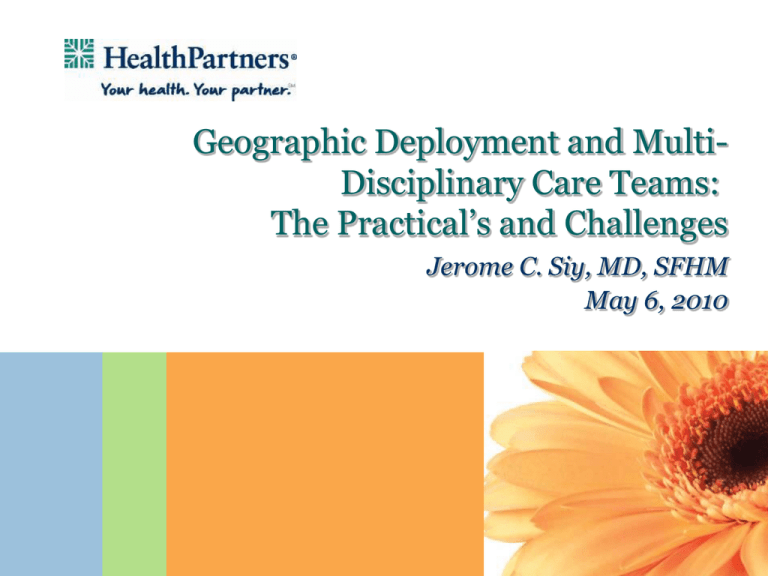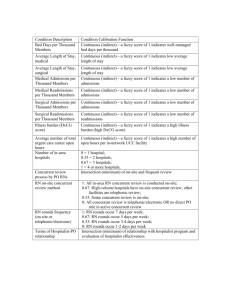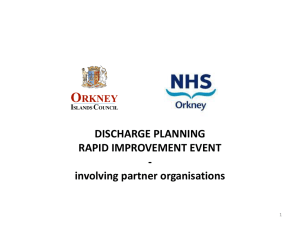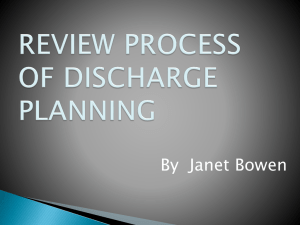Physician Team - Society of Hospital Medicine
advertisement

Geographic Deployment and MultiDisciplinary Care Teams: The Practical’s and Challenges Jerome C. Siy, MD, SFHM May 6, 2010 Presentation Overview • Make the case for geographic placement of your hospitalist practices at your hospitals • Learn how multi-disciplinary care teams improve communication, improve hand-offs, assist in early discharges and improve the overall leadership and accountability structure of hospital units • Create an open dialogue about the challenges and tactics to overcome those challenges in implementation of geographic placement and multi-disciplinary care teams Background on our Care System • HealthPartners Medical Group – Integrated care delivery system aligned with hospital, medical group and payer – Approximately 700 physician multi-specialty practice – Approximately 50 locations in Twin Cities and Western Wisconsin – Hospitalist practice is 70+ providers practicing at 5 hospitals • Regions Hospital, St. Paul, Minnesota – 443 licensed beds • Regularly run 80%-90% of capacity – 14 hospitalist daytime services caring for patients • 4 Teaching Teams • Palliative Care • Medicine-Pediatrics • Surgical co-management • 24/7 Coverage – Tertiary care center for smaller community hospitals – Level I Trauma Center – Teaching affiliation with University of Minnesota – Inner city hospital with large proportion of uninsured, underinsured, Medicare and Medicaid Poll Question #1 Before Geographic • Each hospitalist admitted to all hospital units – ~ 8 MD’s covering a 16 bed unit – Each MD covering on average ~6.5 units • Problems: – Very little nurse/MD collaboration – Poor communication amongst the care team – Very difficult to find a nurse or physician to talk with in person – High number of unnecessary pages – Lots of time wasted traveling from unit to unit • MD’s definitely got their 10,000 Steps in per day – No teamwork Principles of Geographic Assignment • Assign hospitalist service based upon location of the patient in a unit versus “who’s up next” – Principle of keeping fewer MD’s covering the same unit • 80/20 Rule – 100% geographic is not feasible – Surgery schedule drivers – Teaching mix – Patient aggregation rules for nursing and other support • E.g. telemetry, progressive care, etc. • Since geographic deployment in 2005, hospital expanded in Fall 2009 moving from 12-16 bed circles to huge 36 bed “arms” – Continue to refine our model constantly After Geographic Physician Team Primary Units R1-R4 Hospitalist Teaching Services HP5 and HP6 Hospitalist HP7 and HP8 Hospitalist HP9 and HP10 Hospitalist HP11 Peri-Operative Team HP12 Peri-Operative Team HP13 Palliative Care Team HP14 Triage / ED consults HP15 Medicine Pediatrics South 6, 7, 8 South 6, C63 South 7 and South 8 Central 82, 91 South 9 (Beds 9401-9518) South 9 (Beds 9519-9636) Hospice patients n/a Central 54 Geographic Practical's: • Nighttime coverage: No geographic, pure admission service • We too hit points of surge where there could be some teams busier than others – In general, seeing patients in a timely manner trumps geographic – Transfers: in general, physician continuity trumps geographic • Compensation is not a key driver for daily census of the MD’s – Services are all busy enough (our overall staffing level is appropriate) – Productivity has remained stable for the physicians • Physicians rotate their service in the schedule to allow for variety of practice and patient mix adjustments • Due to nighttime assignment and surge, often by the end of the service week we do see slippage – On sign outs (Tuesdays) we go back to geographic – While not perfect, still better than the old method of covering 6+ units Poll Question #2 Care Team Rounds • Once you have MD’s more available on the floors, it becomes easier to assemble the teams • Hardwire team meetings – All meetings occur between 9-10 • Availability for teleconferencing to accommodate disciplines covering multiple units – Some surgical / ICU meetings occurring again in the afternoon to accommodate surgeons or plan for the next day • Each patient should only take 2 minutes to review – All team members on the same page to progressing care and planning for discharge The Care Team • Essential Participants – Physician – RN – Nurse Manager – Social Worker – Case Manager – Pharmacist – Health Unit Coordinator • Other participants may include: – Chaplain – Utilization Review – Specialists – Others • Purpose: – Exchange information critical to quality patient care – First team to be approached for collaborative improvement efforts • E.g. Joint Commission’s Interdisciplinary Care Plan – Facilitate early discharge and discharge planning – Leverage systems, other than the physician, to coordinate care Poll Question #3 Why include the pharmacist? • Better access for dialogue between MD and Pharmacist on medication discussions • Decrease the number of pages between the disciplines • More timely therapy adjustments provide enhanced levels of care • Better information sharing with whole team • Knowing the time of discharge helps align with the discharge preparation process – Preparing for home IV antibiotics and assessment of other high cost discharge medications So, why the HUC, Case Manager AND the Social Worker? • These are the people with the planning skills to get the work done – Arrange for: • Patient education • Ride planning • Coordination with the family • Arranging in advance SNF or Home Care – Many SNFs are short on beds, often need longer lead times to place • Assist the patient in helping with finding financial assistance (e.g. applying for programs) • Coordinating transitions of care (e.g. setting up appointments in heart failure clinic) Content of Rounds: Not every topic addressed due to time, only those of issue • • • Clarify demographic ambiguities – Identify primary or working diagnosis – Observation v. admitted status – Basic information: barriers, language Discharge planning – Anticipated date/time/place – Plan ahead: Ride, home care, follow-up appointment needs, re-admission risk identification Legal-Social Issues – Holds – POA, guardianship – Code status addressed Content of Rounds: Continued • • • • Resource utilization – Safety assistant – Telemetry – Isolation – Change in level of acuity – Lines and tubes (e.g. foley & central line removal) Progression of care guidelines – Identifying needs related to ongoing acute care status – Current functional status/needs – Identify needs for care conference with family Medication plan of care guidelines – Pain management – Progression to PO meds – Need for costly or complex medications (e.g. LMWH) Outstanding orders that need to be completed and plan for followup After Care Team Rounds • Improved patient and family satisfaction through consistent communication of plan of care and realistic discharge expectations • Improved flow by reducing discharge delays – Increased discharge order entry by 9:00am to facilitate earlier discharge (beat the ED rush) • Improved staff and physician satisfaction – Better access to physicians for clinical dialogue, particularly medications – Planful process for discharge activities that are not always clinical, but critical to discharge • Ride planning, SNF placement, patient education • Potential for improved patient safety with thorough, timely and improved communication – Everyone owns the care of the patient Key Measures of Success • Patient satisfaction – Communication scores in HCAHPS – Willingness to recommend • Discharge readiness – Orders written before 9:00am – Discharge time (earlier in the day is better) – Decrease in Milliman Potentially Avoidable Delays • Employee survey results – MGMA Physician Satisfaction – HealthPartners All Employee Survey Questions & Discussion








